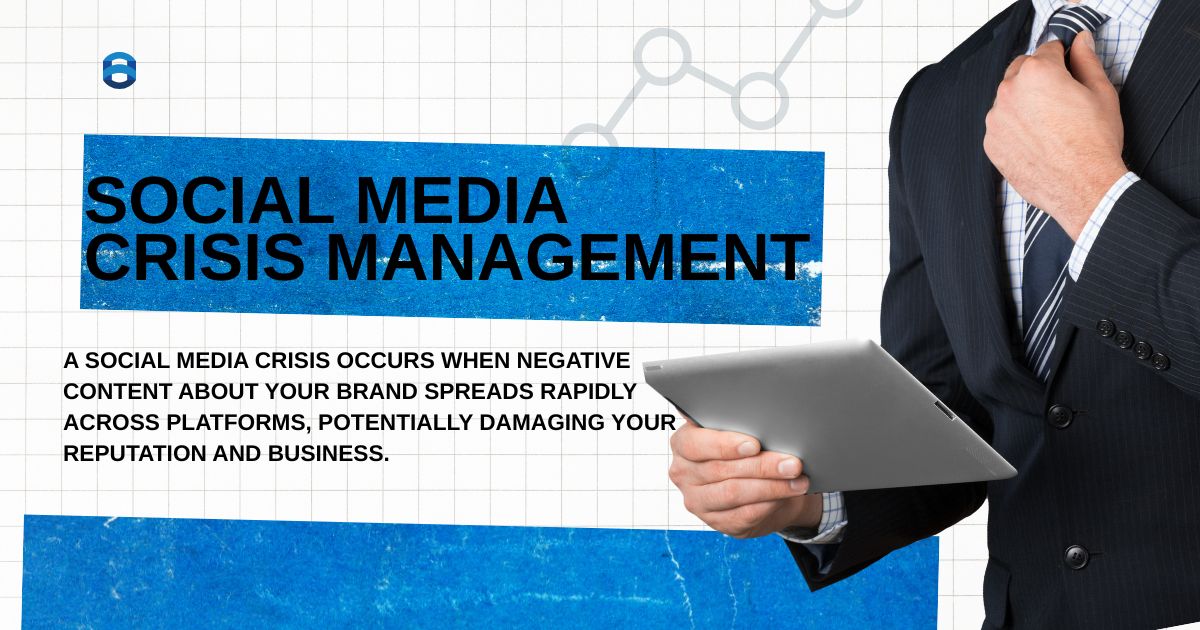
Social media can do or break the reputation of your brand quickly as you can say “viral.” When things go wrong online, the clock starts to last. Every minute means when the negative response spreads to the platforms, before taking into account the problem, when thousands of potential customers.
This guide will drive you through proven strategies to manage crises on social media. You will learn how to react quickly and efficiently when your brand is facing backlash online, as well as discovering the prevention strategy that can save you from future headaches.
Understanding Social Media Crises
A social media crisis management occurs when negative content about your brand spreads rapidly across platforms, potentially damaging your reputation and business. These situations can arise from various sources:
- Customer complaints that gain traction through shares and comments
- Product failures that customers document and share publicly
- Employee misconduct captured on video or in posts
- Offensive content accidentally published by your team
- Misunderstood messaging that sparks controversy
The key difference between a regular complaint and a crisis lies in velocity and reach. A single unhappy customer becomes a crisis when their story resonates with others, creating a snowball effect that amplifies the negative message.
The Anatomy of Social Media Damage
Social media damage typically follows a predictable pattern. Understanding these stages helps you intervene at the right moment with the right response.
Stage 1: The Spark
Someone shares negative content about your brand. This could be a frustrated customer, a concerned employee, or even a competitor. The initial post might seem insignificant, but it contains the seeds of a larger problem.
Stage 2: The Spread
Others begin engaging with the negative content. They share it, comment on it, or create their own posts referencing the original issue. The story starts reaching people beyond your immediate audience.
Stage 3: The Amplification
Influencers, journalists, or other high-profile accounts pick up the story. This stage can transform a small issue into a major crisis as the reach multiplies exponentially.
Stage 4: The Peak
The story reaches maximum visibility. Traditional media might cover it, and it becomes a trending topic. This is the most dangerous phase for your brand reputation.
Stage 5: The Decline
Interest gradually fades as people move on to other topics. However, the damage to your reputation may persist long after the initial crisis.
Learn about How to Write an Effective Press Release
Building Your Crisis Response Team
Effective social media management requires a dedicated team with clearly defined roles. Don’t wait for a crisis to assemble your response squad—prepare them in advance.
Essential Team Members
- Crisis Manager: This person leads the response effort and makes final decisions about messaging and strategy. They should have authority to act quickly without lengthy approval processes.
- Social Media Specialist: Your social media expert monitors conversations, responds to comments, and manages your brand’s online presence during the crisis.
- Public Relations Professional: This team member crafts official statements, manages media relationships, and ensures consistent messaging across all channels.
- Legal Advisor: When crises involve potential legal issues, having a lawyer on your team helps navigate complex situations without making matters worse.
- Customer Service Representative: This person handles individual customer concerns and complaints that arise during the crisis.
Response Protocols
Establish clear protocols for different types of crises. Your team should know exactly what to do when specific situations arise:
- Who has authority to publish responses
- What approval processes must be followed
- How quickly responses should be posted
- Which platforms take priority
- When to escalate to senior leadership
The 24-Hour Response Framework

Speed matters in social media crisis management. Research shows that brands have approximately 24 hours to respond before public perception becomes significantly harder to change.
Hour 1: Assessment and Alert
- Identify the scope: How many people are talking about this issue? Which platforms are affected?
- Assess the severity: Is this a minor complaint or a major crisis?
- Alert the team: Notify all crisis team members immediately
- Gather facts: Collect accurate information about what actually happened
Hours 2-4: Initial Response
- Acknowledge the situation: Post a brief statement showing you’re aware of the issue
- Express empathy: Show that you understand people’s concerns
- Promise action: Commit to investigating and providing updates
- Monitor closely: Track how the situation develops after your initial response
Hours 5-12: Detailed Response
- Provide specifics: Share what you’ve learned about the situation
- Outline solutions: Explain what you’re doing to address the problem
- Take responsibility: Accept accountability where appropriate
- Offer compensation: If relevant, provide remedies for affected customers
Hours 13-24: Follow-up
- Update on progress: Share what actions you’ve taken
- Address ongoing concerns: Respond to new questions and comments
- Reinforce your commitment: Demonstrate that you’re taking the situation seriously
- Plan long-term changes: Communicate any policy or process changes
Response Strategies That Work
Different types of crises require different response approaches. Here are proven strategies for common social media crisis scenarios:
The Genuine Mistake
When your brand makes a real error, honesty and transparency work best. Acknowledge the mistake, apologize sincerely, and explain how you’ll prevent it from happening again.
Example response framework:
- “We made a mistake when we…”
- “We understand why this upset people”
- “Here’s what we’re doing to fix it”
- “We’re changing our processes to prevent this in the future”
The Misunderstanding
Sometimes crises arise from miscommunication or misinterpretation. In these cases, clarification is key, but avoid making people feel foolish for misunderstanding.
Example response framework:
- “We see there’s confusion about…”
- “Let us clarify what we meant”
- “We should have been clearer in our original message”
- “Thank you for bringing this to our attention”
The False Accusation
When your brand is wrongly accused, resist the urge to respond defensively. Instead, calmly present facts and evidence while maintaining a respectful tone.
Example response framework:
- “We’ve seen reports that…”
- “Here are the facts about the situation”
- “We’re happy to provide additional information”
- “We appreciate the opportunity to set the record straight”
Prevention: Your Best Defense
The most effective crisis management happens before crises occur. Building strong prevention practices reduces your risk of facing serious reputation damage.
Content Review Processes
Implement approval workflows for all social media content. Multiple people should review posts before they go live, especially for:
- Sensitive topics
- Promotional content
- Time-sensitive posts
- Content from new team members
Employee Training
Train everyone who has access to your social media accounts. They should understand:
- Your brand voice and values
- What topics to avoid
- How to handle negative comments
- When to escalate issues to management
Community Management
Active community management helps you catch problems early. Respond to comments and messages promptly, and address concerns before they escalate.
Monitor conversations about your brand across all platforms. Use social listening tools to track mentions even when people don’t tag your account directly.
Crisis Simulation
Practice crisis scenarios with your team. Run through different situations and test your response protocols. This preparation helps everyone stay calm and focused when real crises occur.
Platform-Specific Considerations
Each social media platform has unique characteristics that affect crisis management:
- Longer response times are acceptable
- Detailed explanations work well
- Private messages can help resolve individual concerns
- Comments are easily organized and manageable
- Immediate responses expected
- Character limits require concise messaging
- Conversations move quickly
- Hashtags can amplify both positive and negative content
- Visual content is crucial
- Stories provide temporary response options
- Comments are less prominent than other platforms
- Influencer involvement can escalate quickly
- Professional tone is essential
- Detailed explanations are appropriate
- Business-focused audience
- Slower spread but longer-lasting impact
Measuring Crisis Impact
Track specific metrics to understand how crises affect your brand:
Sentiment Analysis: Monitor the tone of conversations about your brand
Reach and Impressions: Track how far negative content spreads
Engagement Rates: Measure how people interact with your crisis responses
Follower Count: Watch for significant gains or losses during crises
Website Traffic: Monitor changes in site visits and behavior
Sales Impact: Track revenue effects during and after crises
Learning from Crisis Experience

Every crisis provides valuable lessons for improving your future response capabilities.
Post-Crisis Analysis
After the immediate crisis passes, conduct a thorough review:
- What triggered the crisis?
- How effective was your response?
- What would you do differently?
- What processes need improvement?
Documentation
Keep detailed records of crisis events and responses. This documentation helps train new team members and improves future crisis management.
Process Refinement
Update your crisis management procedures based on lessons learned. Social media evolves constantly, and your crisis response should evolve too.
Don’t miss our latest blog Emotional Intelligence in Crisis Communication
Building Long-Term Resilience
Strong crisis management is outside of injury control. It creates flexibility with a long time that helps in the storms of the future during your brand season.
Be aware of having a real relationship with the audience. When people depend on your brand, they are more likely to give you the benefit of doubt in difficult situations.
Be active to address possible problems before the crisis is created. Your content, procedures and team functions help identify regular audit weaknesses.
Create a culture of openness and responsibility in your organization. When everyone understands the importance of using the responsible social media, the chances of having problems are less.
Your Crisis Management Action Plan
Crises on social media are indispensable for most brands, but they do not have to be devastating. With proper preparation, quick response and real commitment to improvement, you can make potential disasters the ability to show the values and reliability of your brand.
Start building your crisis management features today. Collect your team, make your response protocol and start practicing crisis landscapes. When you invest now, you pay dividends if you meet your next challenge on social media.
Remember that crisis management is a continuous process, not the determination of once. Continue to refine your approach, stick to trends on social media and maintain open communication with the audience. The reputation of your brand depends on how well you tackle those moments when you go wrong.


















No Comments